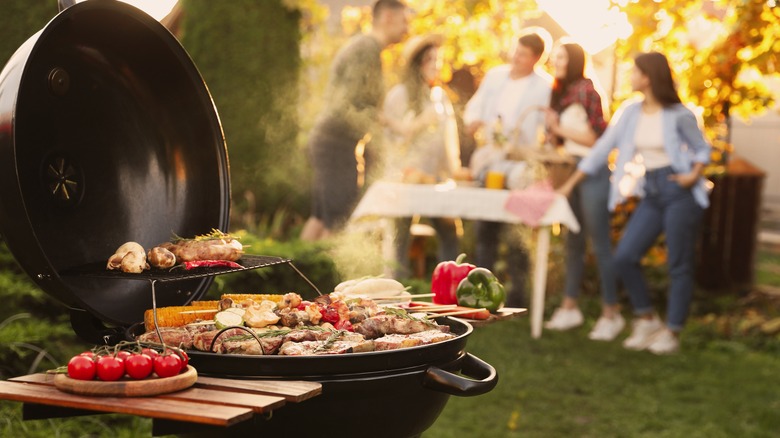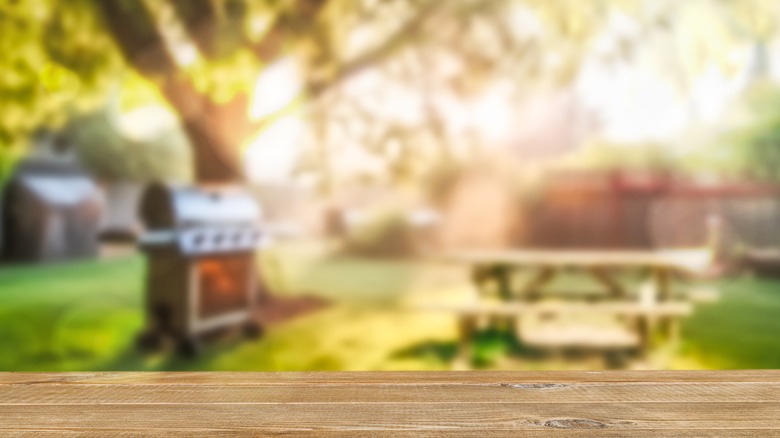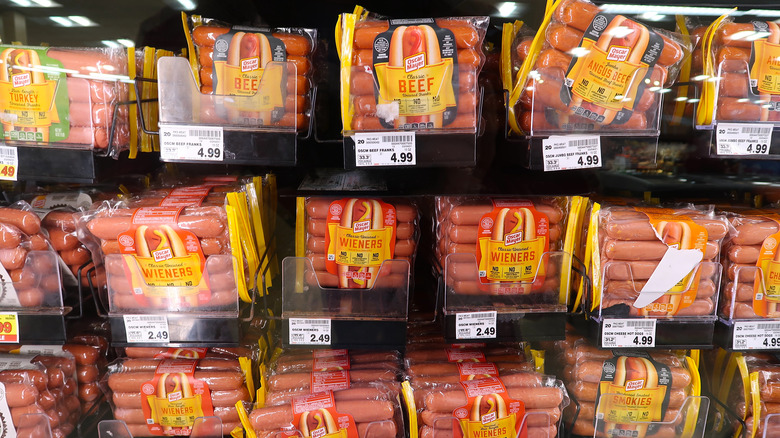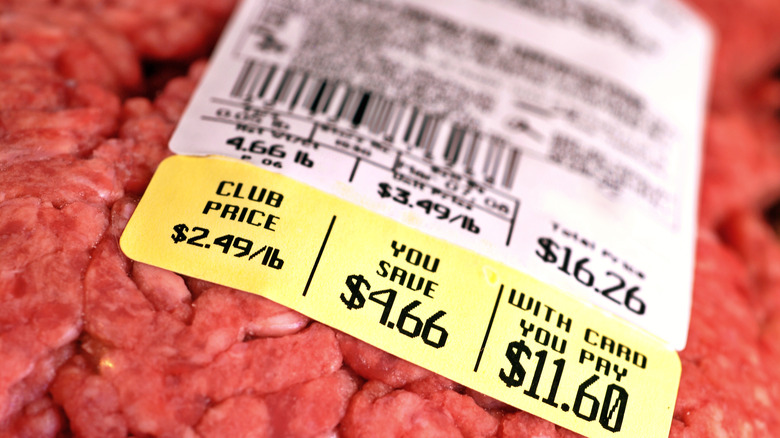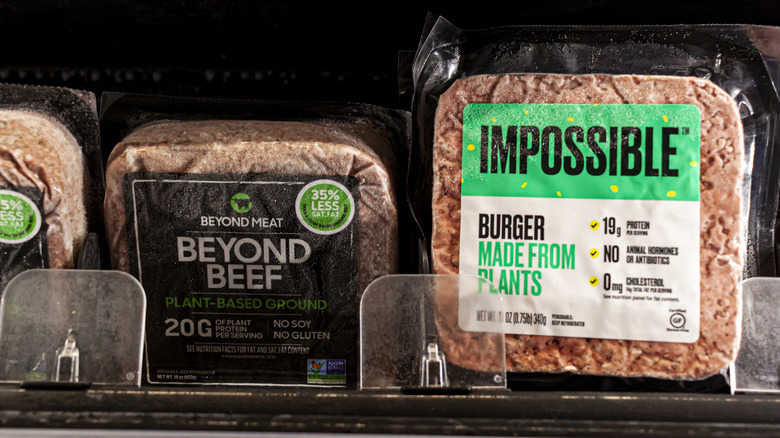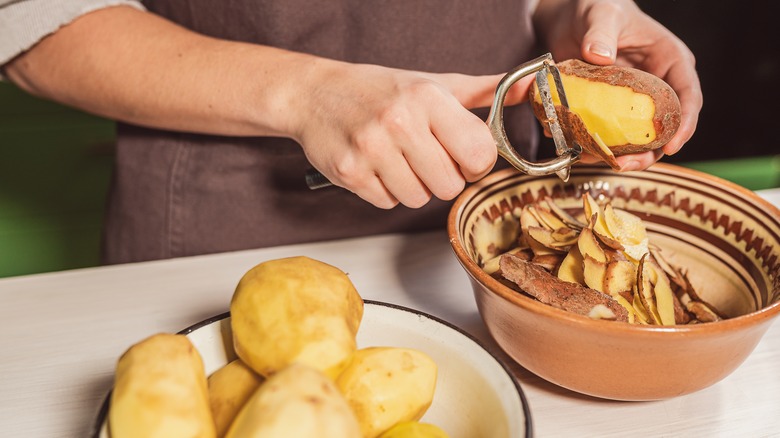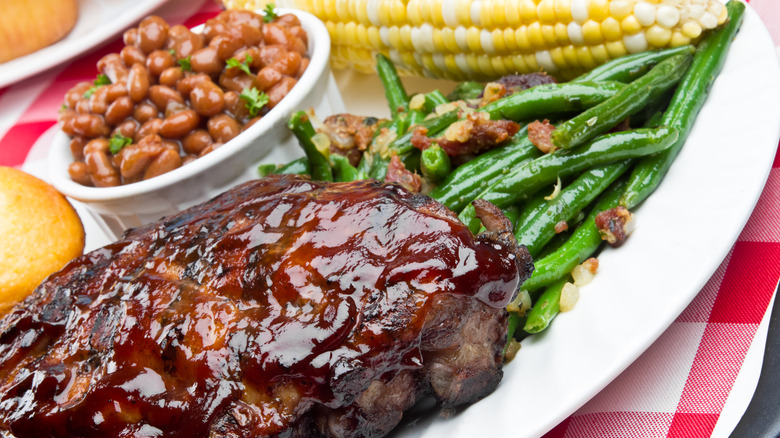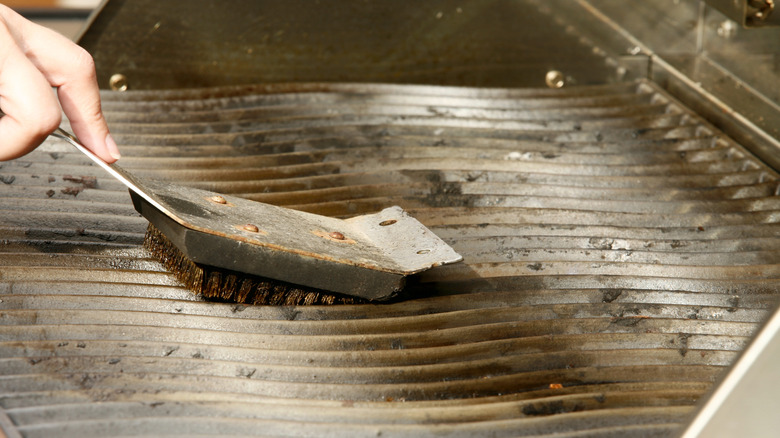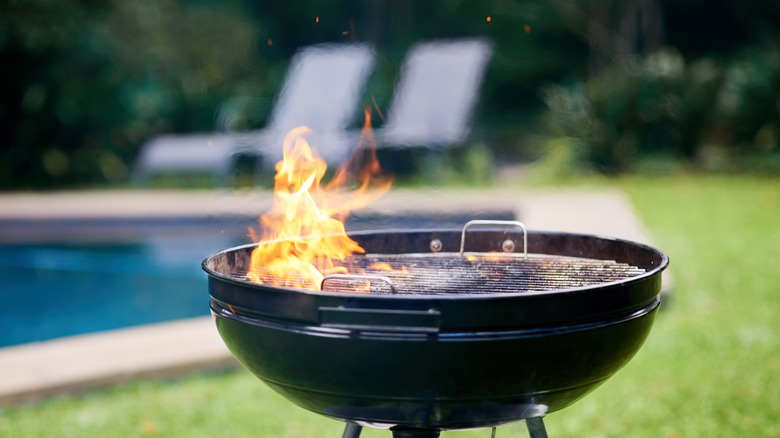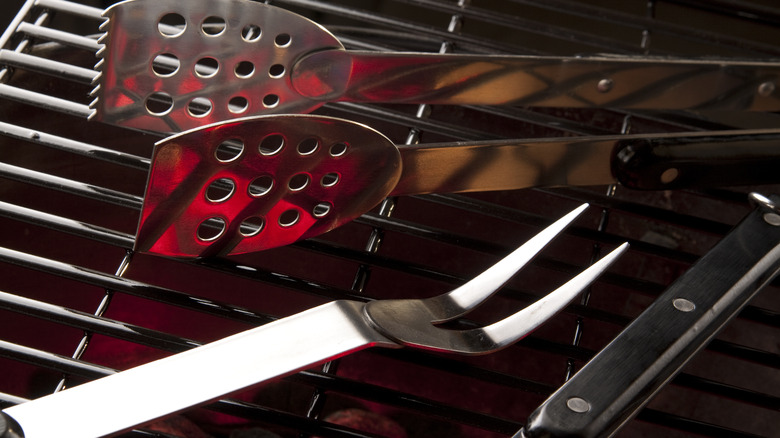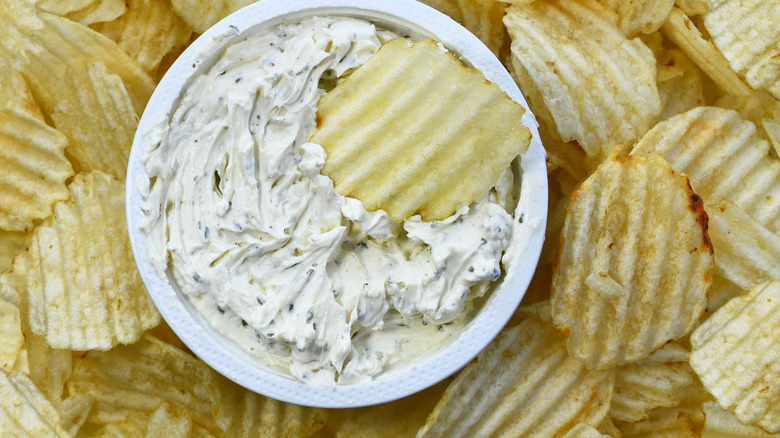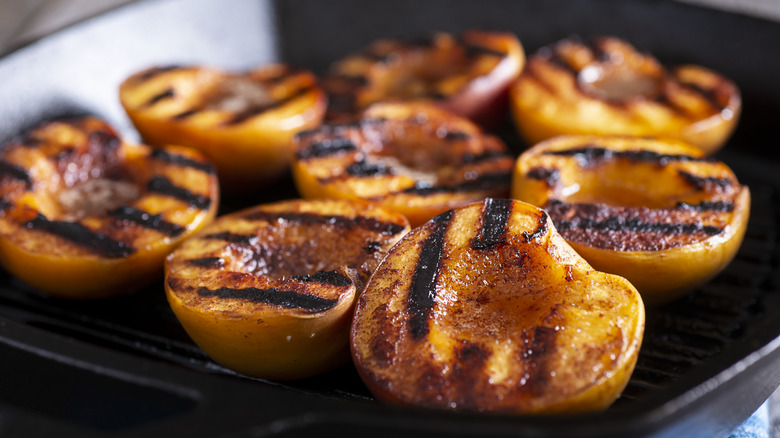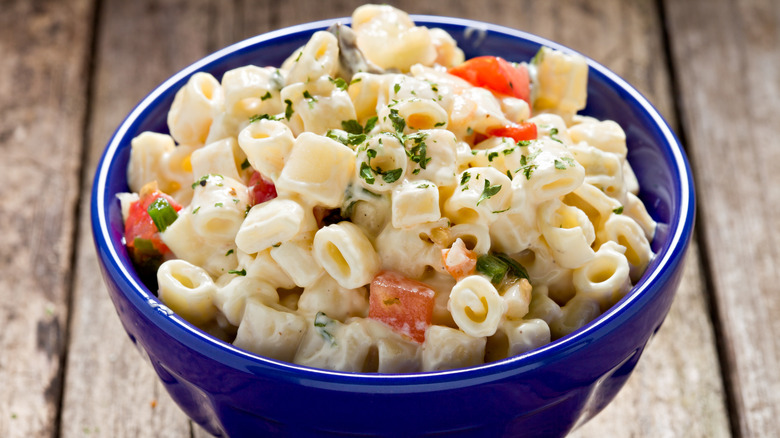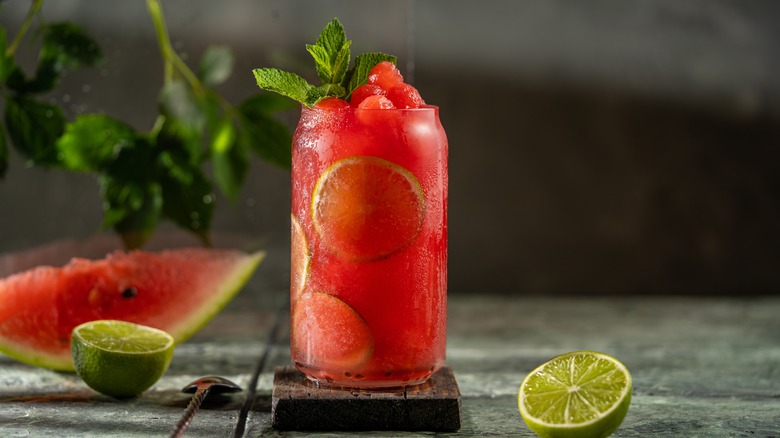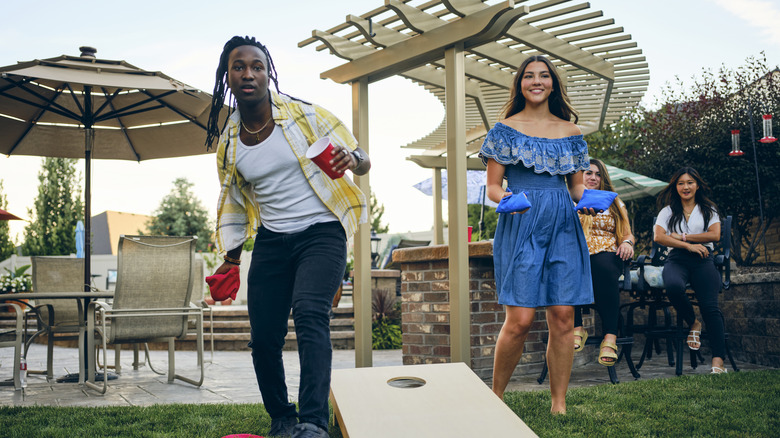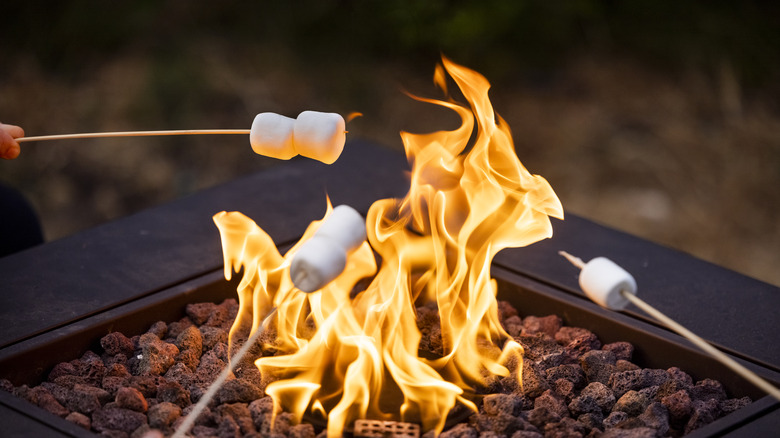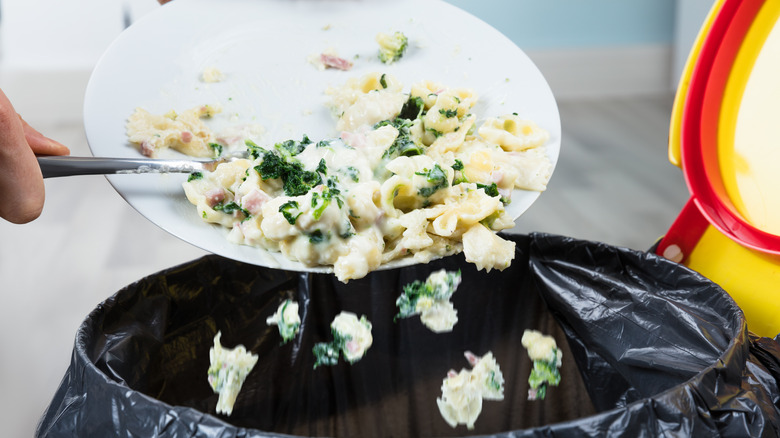16 Tips You Need For Planning The Perfect Summer Barbecue
Barbecues are an important part of the traditional American summer experience. These events gather together your closest family and friends with a couple of trays of hot dogs, your aunt's famous potato salad, and tons of laughs shared together with each other. Truly, there is no better way to enjoy a perfect summer night. Unless, of course, you didn't take the time to plan your barbecue methodically. Then, it just turns into last-minute runs to the store for condiments and hamburger buns, everyone getting attacked by mosquitos, and a night that you wish you weren't the person responsible for.
Although barbecues seem like the kind of event everyone can lazily stroll into, some important preparation components are key to a successful, safe, and delicious barbecue. Here are some of the most important things you need to consider before you send out your barbecue invitations and pull out your grilling tongs.
1. Design your space for entertaining
The first step in planning your barbecue is the when and where. These questions will often depend on how many people you plan on hosting. For example, if you plan on inviting 30 people to your 100-square-foot yard for a barbecue, you'll likely have to seek some sort of alternative arrangement. Parks, campgrounds, and community centers can provide another option for hosting space; many already have charcoal grills available for use. If you are going this route, we recommend calling ahead to ask how many people you can host, as well as what kind of resources are provided – like picnic tables and access to a bathroom.
Hosting at your home is a little easier but will require some preparation. First, decide where people will eat (like at a table or sitting on blankets on the ground) and where the food will be located. Plan for small things like trash bins, citronella candles, and shade canopies to help make your guests feel more comfortable.
2. Calculate how much food you'll need to purchase before going to the store
Once you have a suitable venue and decide on how many people you plan to host, you can start making your grocery store list. The amount of food you get will depend on your options; the more food variety you have, the less of each item you'll need (unless that item is watermelon, which everyone eats a lot). Assume that roughly every adult will eat 6 to 8 ounces of protein total and about one-half to a full cup of sides per person — or around five ounces. Children typically eat between 4 and 6 ounces of protein. If you're serving food with bones, like spare ribs or chicken wings, you'll need to increase this factor slightly.
If you're serving appetizers like chips and dip, you'll want to aim for a pint of dip and a pound of chips (or sliced veggies) per ten people. As far as drinks, you'll want to have about two pounds of ice on hand for each person, and increase this factor if you expect some sweltering weather. Assume adults will drink about three beers or two to three cans of soda each, as well. We also recommend having ample water on hand for all of your guests.
3. Shop in bulk for great deals
Everyone likes a good deal — especially when you're cooking for 20! But, if you want to get great deals on your barbecue favorites, you will have to move fast and plan ahead. Typically, grocery stores will run specials leading up to big weekends like Memorial Day and Labor Day on condiments, burgers, hot dogs, and other barbecue staples. So scope out your circulars or grocery app to see where to get the best deals on your barbecue must-haves.
Bulk grocery shopping is a good idea if you are hosting a lot of people at your barbecue. You'll get much better deals on jumbo-sized condiments, frozen meats, and 18-packs of buns. If you're making a run to your local Costco, make sure you note how much space you have in your refrigerator or freezer to store food before you leave to ensure you can fit your purchases in a safe place.
4. Always supply plant-based options
Dietary restrictions and barbecues have historically been at odds with one another. But there are now more products than ever that can help you accommodate plant-based eaters at your barbecue. Our favorite plant-based burger brands include Beyond Meat and Impossible Foods; these pre-shaped meat patties grill just like a meat burger and don't require any additional preparation steps. You can even find these burgers in bulk at some clubs or grocery stores. When you're grilling, just be sure you know where the real meat is.
Plant-based eaters also have options besides burgers. One of our favorite products for grilling is Beyond Meat brats; these "sausages" are very meaty in flavor and are especially delicious when placed on a bun and smothered in ketchup. You can also offer some plant-based sides at your barbecue to tailor to all kinds of eaters, like our jalapeño-lime three-bean salad recipe.
5. Prep as much food possible in advance
You're not an egg, so there's no reason to scramble. Before your barbecue, you'll want to prepare as many parts and components as possible so you'll be less rushed the day of. This includes prepping dishes like pasta salad, potato salad, sliced veggies, and accompanying dips.
Several foods actually benefit from being prepared in advance – and more than just for your time and sanity's sake. You should prepare your burgers the night before because the chilled patties will stay firm in the fridge, making them easier to grill the next day. When you're ready to grill, allow the burgers to sit out at room temperature so they will cook when they hit the flame. Potato salad is another food that gets much better when you prepare it ahead of time; you should allot at least four hours for the flavors to meld together.
6. Consider having your guests bring the sides
Potlucks are one of the best concepts ever invented. After all, if people aren't paying for you to cook food for them, it's not unreasonable to ask everyone to bring at least one thing to the barbecue — even if it's just a bowl of store-bought cookies that they remembered on the way over. If you're going the potluck route, it's essential to ask your guests to bring side dishes, beverages, or food that is otherwise not critical to your barbecue happening. For example, it's no big deal if your aunt forgets to bring her crock of baked beans since you'll have other side dishes there, but you have a problem if your cousin fails to bring the dinner plates.
Many folks will supply the barbecue and the proteins, while guests supply the sides, desserts, and alcohol. This model allows you to get some diversity in food at your barbecue and will save you a ton of time and money. Plus, you can assume everyone is bringing something they can eat, which is an easy way to accommodate any dietary restrictions.
7. Properly clean your grill before using it
Don't let yourself fall behind on the day of your barbecue. Getting the preparation steps out of the way is essential — and one of the foremost is cleaning your grill. Food that has stuck to the grill can cause unequal heating — and make your chicken kebabs taste like whatever you last grilled the week prior.
You don't need special cleaners for your grill; you'll just need a coarse cleaning brush or some aluminum foil. You should stop cleaning your grill with a wire brush and inspect it before you start cleaning to prevent inadvertently eating a wire bristle. Replace your brush if you notice it looks worn or bent.
Clean both the grill grates and the charcoal grates with the brush or crumbled aluminum foil to remove small food particulates. You can also clean the ash catchers and the bottom of the grill with the brush before emptying the debris into a bag. Before you go to the grill, use the brush to clean the grates off and use oil to prevent the food from sticking.
8. Prioritize grilling safety
According to the National Fire Protection Association, the number one cause of both home cooking fires and death caused by those fires is unattended cooking. Don't let your barbecue be one of these statistics; use common sense to ensure you and your guests have a safe experience.
Besides not leaving your grill unattended while lit, you should be sure to keep the space around your grill safe and free of hazards like pot holders and paper napkins. Place the grill at least 10 feet away from your home or structure, and ensure that it is on a flat surface. You should also place your grill away from where people gather (especially children) to prevent accidental burns.
It is also essential to always grill in a well-ventilated space to prevent dangerous fumes from lingering. Finally, if you're the person grilling, make sure to avoid wearing baggy clothes and tie apron strings behind your back rather than in the front. There are some essential items you need to have for safe grilling. Keep a spray bottle filled with water nearby for flare-ups, and have a fire extinguisher on hand for emergencies.
9. Make sure you have all of your grilling and serving tools handy
Since you shouldn't leave your grill unattended at any time, you will want to ensure you have all of the tools you need for grilling nearby. Your essential grilling tools will depend on what you're making, but usually include a few staples like a pair of long grilling tongs, a thermometer, a silicon basting brush (if you're making ribs), a grill basket (for smaller pieces of meat and veggies), a roll of aluminum foil, and serving plates. To alleviate food safety concerns, ensure you have a clean plate for cooked food and clean utensils.
One of the absolute essentials for grilling that many folks forget to grab before their event is the fuel itself. You'll need to stock up on charcoal or propane before your barbecue starts — we recommend having some extra on hand in case you need it.
10. Keep your snack table moving
Snacks are a vital component of a great barbecue. If your guests don't all know each other already, or it's taking a little bit longer than usual for you to finish grilling your proteins, you'll always have a good snack table to tide your guests over until the meal is ready. Start by always placing your snack table away from the grilling space to prevent people from congregating close to the open flames. The kinds of snacks you choose to serve will depend on the formality of your barbecue and what types of people you're serving.
For example, if you have a ton of children at your barbecue, you're going to want to serve finger food like chips, dips, and sliced veggies. On the other hand, if you're going for a fresca feel, try making a fresh pico de gallo or serving pita chips and hummus. Grazing boards and charcuterie require a bit more effort and planning, but they can provide a little more upscale feel to your barbecue.
11. Use your grill for more than just meat
Allow your grill to be the centerpiece of your barbecue. Instead of reserving it for just your proteins, try grilling up some fruits and veggies on it, too. Be sure to start by scrubbing your grill clean in between cooking the proteins and the produce; when you're grilling fruit, you'll find that the sugars cause a ton of sticking that can easily ruin your grilling game. You should also grill produce hot to get perfect grill lines and prevent the fruits and veggies from drying out too fast.
Some of our favorite produce to grill include stone fruits (like peaches, cherries, and apricots), pineapple, corn-on-the-cob, peppers, and onions. You can chop the fruits and veggies in advance and leave them in your fridge until it's time to grill. Then, add a squirt of citrus or your favorite spices to help amplify the flavors.
12. Find a way to keep cold foods cold
Barbecues most often happen on hot summer days — which is great for gathering more than just people. Unfortunately, bacteria and foodborne pathogens love environments where food is left out and is hospitable. One of the most dangerous foods you can eat at a barbecue is anything with a mayonnaise or cream dressing — like macaroni salad, potato salad, and ambrosia salad — left out at room temperature for more than two hours. On warm days when the temperature exceeds 90 degrees Fahrenheit, this window of safety may only be about an hour.
One of the easiest ways to keep your salads cold is to place the salad bowl inside a larger bowl that has been filled with ice. You can also fill a shower cap with ice and wrap it around the bowl. And if your salad sits out at room temperature for too long, throw away the leftovers.
13. Make a signature non-alcoholic beverage to serve
One of the easiest ways to customize your cookout is to make a signature beverage for your guests. While you can go the alcohol route, we recommend sticking with a mocktail. It will keep your guests hydrated and might even appeal to some of the younger visitors. For example, if you're looking to keep things manageable, you can set up an Arnold Palmer bar with containers of iced tea and lemonade. Guest can pick their ratio and enjoy the nostalgia behind one of the best barbecue beverages ever made.
One of our favorite drinks to make is a watermelon lemonade; you'll get the refreshing flavor of the watermelon with the tanginess of the lemon juice and zest. Once you strain your watermelon lemonade, add it to a large glass pitcher for your guests to serve themselves. Although a cocktail cart (of sorts) may seem fancy, it's just another thing for you to manage at your barbecue.
14. Plan other activities besides the food
Although it might seem like a given, you should consider setting up some games and entertainment for guests at your barbecue. While the food itself may be the star of your show (as it should), you should also plan for a late start, forgetting to get something from the grocery store or a myriad of other factors that may mess up your precarious timeline. Games like cornhole or lawn darts are an easy way to distract guests and keep everyone occupied until the food is ready.
One of our favorite easy ways to help people start conversations and meet one another is by setting question cards up throughout the barbecue space. This icebreaker is particularly useful for getting folks acclimated to the setting and helps spark many laughs. You can make these cards yourself with questions like "Where is the most exotic place you've traveled to?" and "What animal do you wish you could domesticate and why?" or purchase a card deck from an online retailer.
15. Skip the complicated desserts and make s'mores
After your guests have finished the main course, it's time to think about dessert. There are some go-to options for barbecues, including our least favorite: ice cream. Yes, we do love ice cream, but on a hot summer day when you have to scoop melty, sticky ice cream into tiny bowls, you might feel the same as we do. Instead, there's a much better dessert option requiring very little preparation.
S'mores are a quintessential barbecue dessert for all ages. You'll just need to have a fire handy, as well as marshmallow sticks, marshmallows, and s'more ingredients. If you want to add a personal spin to the s'more experience, try making a snacking board with more than just the standard s'mores ingredients. You can use cookies instead of graham crackers, peanut butter cups instead of chocolate, and different flavors of marshmallows for your guests to customize their s'more experience. Once your guests are done, they can toss the sticks in the trash, and you can rejoice in some easy cleanup after your perfect barbecue.
16. Plan for leftovers
There's no dinner party without leftovers. But, as the host, you'll need to answer some critical questions to help you streamline the leftover process. First, do you want to eat leftover hamburgers and potato salad for the next four days or send some home with your guests? If you go with the latter, how will your guests take their food home with them? Rarely does it make sense to have guests put their leftovers in the containers they came in, so you should be prepared to have some containers on hand to give to your guests.
Plastic meal prep containers are an excellent item to stock up on in anticipation of your barbecue. That way, you won't have to give out your favorite Tupperware containers, knowing well enough that it is unlikely your guests will return them. Instead, leave the containers on the table at the end of the meal and allow your guests to scoop their own portions. Then, store whatever is left for yourself; we bet you'll have enough for a few days.
